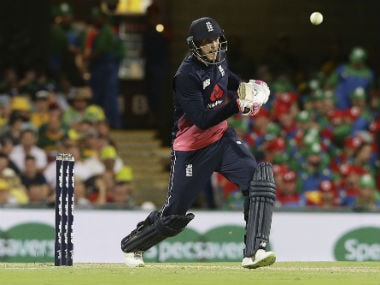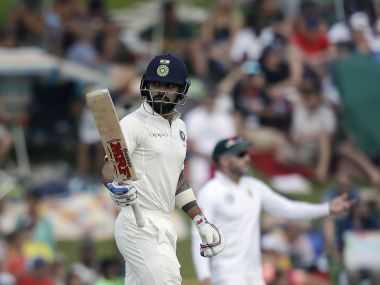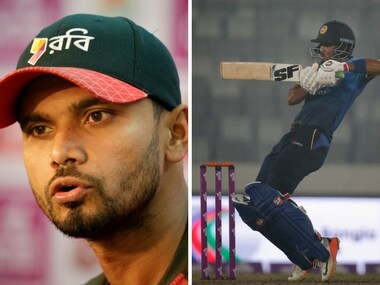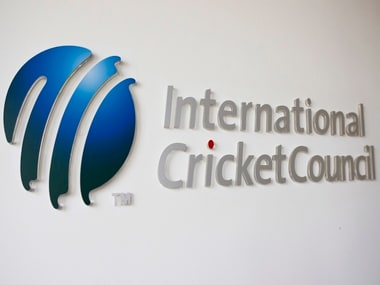India vs South Africa: Virat Kohli, AB de Villiers and the importance of their support systems
Indian fans were looking forward to 2018. As Kohli inherits Sachin's mantle of the lone ranger, they must now feel like they've travelled back in time.
Jigar Mehta, Jan,19 2018
- ICC Under-19 World Cup, 2018 IND Vs ZIM India Under-19 beat Zimbabwe Under-19 by 10 wickets
- ICC Under-19 World Cup, 2018 AUS Vs PNG Australia Under-19 beat Papua New Guinea Under-19 by 311 runs
- ICC Under-19 World Cup, 2018 SL Vs PAK Pakistan Under-19 beat Sri Lanka Under-19 by 3 wickets
- ICC Under-19 World Cup, 2018 BAN Vs ENG England Under-19 beat Bangladesh Under-19 by 7 wickets
- ICC Under-19 World Cup, 2018 NAM Vs CAN Canada Under-19 beat Namibia Under-19 by 4 wickets
| Rank | Team | Points | Rating |
|---|---|---|---|
| 1 | India | 4969 | 124 |
| 2 | South Africa | 3888 | 111 |
| 3 | Australia | 4174 | 104 |
| 4 | New Zealand | 3489 | 100 |
| 5 | England | 4829 | 99 |
| 6 | Sri Lanka | 4058 | 94 |
| Rank | Team | Points | Rating |
|---|---|---|---|
| 1 | South Africa | 6386 | 120 |
| 2 | India | 6680 | 119 |
| 3 | England | 6483 | 116 |
| 4 | New Zealand | 6550 | 115 |
| 5 | Australia | 6077 | 113 |
| 6 | Pakistan | 4875 | 96 |
| Rank | Team | Points | Rating |
|---|---|---|---|
| 1 | New Zealand | 2262 | 126 |
| 2 | Pakistan | 2843 | 124 |
| 3 | India | 3385 | 121 |
| 4 | England | 2029 | 119 |
| 5 | West Indies | 2538 | 115 |
| 6 | South Africa | 2238 | 112 |





"There goes this series......": Harsha Bhogle
"Unfortunately it's all over. Kohli gone, India gone.": Mohammad Kaif
"Out And Over...."": Aakash Chopra
The collective flow of emotions at the end of the 15th over of India's second innings jetted the mind back to the 1990s era. At Centurion and all over the world, a bevy of minds were resigned to the fact that India's chances of keeping the 3-match Test series against South Africa alive were gone as a helpless Virat Kohli crouched on his crease, ecstatic debutant Lungi Ngidi set off in early celebration and umpire Michael Gough raised his finger.
File picture of Virat Kohli. AP
India were used to this feeling for many years back in the 1990s. It was the 'Sachin Tendulkar gone, TVs switched off' era which was punctuated by the enduring image of a helpless Little Master standing motionless at the non-striker's end in a cross-legged stance, with one of his arms resting on the bat as he watched his partners arrive and depart.
It was the period when Tendulkar was the lone ranger, always in search for his support system with the bat which went missing most of the time and malfunctioned at the other.
And on the rare occasions when he failed, it elicited emotions similar to the ones on Tuesday as Kohli trudged back to the pavilion.
This current Indian side was the No 1 Test team in the world with nine series wins on the trot. This was the side which had the best team batting average per wicket last year (44.72). This was the side that had amassed the most number of centuries (19) in the same period and yet with 252 runs needed with seven wickets in hand on the final day at Centurion, no one gave them a chance. Not even the greatest of optimists.
"Honestly, with Virat Kohli gone, I don't think India is capable of winning the match now," Indian batting legend Sunil Gavaskar said in the post-match show. The resignation in his voice was palpable.
Sanjay Manjrekar put things into perspective to start off the post-game show on Day 4 when asked whether three wickets had shut the door (for India) a little bit. "35/3 and more importantly, among the three, Virat Kohli is gone. India have become at this stage in overseas Test series a one-man batting team and that man's gone."
Such has been the dependency on one person in the Indian batting line-up.
For South Africa, AB de Villiers wasn't even a sure starter in the first Test but as the series progressed, his role started becoming crucial but, for the Proteas, it wasn't just about him.
Yes, Kohli and De Villiers are in a league of their own. Yes, they bat on an altogether different plane. Yes, the state of the pitch doesn't bother them. Yes they form the strong bases on which the Indian and South African edifices are built, but to achieve stability, what also matters is the strength of the pillars that provide crucial support. Kohli's pillars wobbled and that proved to be the game changer.
What explains the importance of support system in batting is the fact that Kohli is the only centurion in the series so far but there is just one Indian batsman apart from him who has had a fifty-plus score — Pandya (93) in the first innings of the Cape Town Test.
South Africa, on the other hand, might not have had a centurion but they have seven fifties. De Villiers has just two of them, which explains the importance of the contribution from the others.
None of India's specialist batsmen averaged more than 20 apart from Kohli. While four of South Africa's specialist batsmen averaged more than 20.
And this brings out the value of partnerships too. South Africa have two century partnerships (114 between De Villiers-Du Plessis and 141 between De Villiers-Elgar) and five fifty-plus stands, with De Villiers being involved in both the century stands and one fifty-plus stand which says a lot about the support he received from the other end.
India, on the other hand, have had four fifty-plus stands. Of which one was between Rohit Sharma and Mohammed Shami in the second innings at Centurion when the match was already lost. They don't have a 100-plus stand, though they came close with 99 between Pandya and Bhuvneshwar.
"Partnerships of 60s and 70s don't win you Test matches. We've seen that in the past as well and identified, you need the guys to put their heads down and try to make 60 and 70 partnerships into 100 or 150 to give the team the best chance of winning the Test match or be in a solid position," Kohli said in the post-match press conference.
"Similarly, when you are batting as well, you need big hundreds and not get out after 100 so that the team can benefit from that. So we take the same mindset we take in partnerships also. We did well in Australia, we got 450 every first innings, our partnerships were massive that is something we haven't repeated here. South Africa did that better than us. They didn't have many partnerships but whatever they had, one big partnership was always there and that was the key to them consolidating those situations and they deserve to win the series."
In both the Tests, at Newlands and SuperSport Park, it were the first innings totals that defined the series.
On a decent batting track in Centurion, Kohli was in his zone and in this mode his defense is impregnable and stroke-making sumptuous. This was India's best chance to take the lead with the pitch looking flat. For a moment it seemed a reality. For a moment Vijay and Ashwin provided hope for Kohli but it disappeared prematurely. All Kohli needed was support and it crucially went missing.
Kohli ended up scoring a staggering 49.83% of India's total of 307 with his 153 off 217 balls. The difference between top-two scorers in India's first innings was 107 (Kohli 152 and Vijay 46) — the second most for India in a completed Test innings in South Africa after the second innings at Port Elizabeth in 1992-93 where the difference was 112.
Kohli's control and focus was something that was needed to be captured, packaged, converted into Powerpoint presentation and shown on the loop to the rest of the batsmen who were guilty of poor shot selection.
India gave away a 28-run lead. In a series where the margin of error is very minimal, this was a cardinal sin.
"Yeah (the wicket gave us our best chance). We thought the wicket was really flat. Quite surprising," Kohli said in the presentation ceremony. "I thought it was our chance to put some runs on the board. Especially after SA lost wickets in the first innings, we should have capitalised. We failed to get a good partnership and take the lead. We have let ourselves down from the first game into the second."
When South Africa came back to bat in their second innings of the second Test, they were pegged back early at 3/2 but just like the first innings, De Villiers went on the counter. 80 off 121 balls. What helped the 33-year-old immensely was Elgar's (61) grit and resolve at the other end. Together they added 141 for the third wicket, the second century stand for South Africa in the series. Then there was a mini collapse and the match hung in balance again.
There was still a lot of work to be done. This is where Faf du Plessis put his hand up again. He had done it in the first innings of the first Test and repeated the feat at Centurion, with some attritional batting which occasionally raised questions about his intent. He slowly dragged South Africa's lead in the 2nd innings past 250 as he added 82 runs with the lower order at a time when Shami was breathing fire with his reverse swing.
"For me the vital part was in the second innings when we kept pushing what they needed to get. We knew anything above 250 would be tough and that's why our batsmen grinded," Du Plessis said at the post-match presentation.
In the first innings at SuperSport Park, when De Villiers didn't contribute significantly and there was a mini collapse from 246/3 to 251/6, it was Du Plessis who pushed the Proteas past the 300 mark adding 82 runs with the lower-order. Markram (94) and Hashim Amla (82) had also chipped in with significant contributions earlier.
Reverse was the case in India's second innings. With Kohli back in the hut early, the rest of Indian batting order came down crashing like a drunken party goer getting out of a late night taxi. They seemed in more of a hurry than a cranky kid dragging their father to the candy store.
"So many soft dismissals in this match hurts a lot," Kohli lamented after the loss. "We repeated the same mistakes in both the matches. There were many soft dismissals which as a team was not acceptable."
At Newlands, South Africa had got off to the worst possible start at 12/3 inside the first five overs. It was then that De Villiers showed his class and went on the counter (65 off 84 balls). He triggered a significant turnaround but after his departure, at 126/4, the work was just half done. The middle and lower-middle order amassed 160 more runs. Du Plessis was there, slipping under the radar, and slowly eroding India's confidence with 62 and on a surface where he considered 270 as par, South Africa had posted 286. There was just one century partnership in the match — between De Villiers and Du Plessis (114).
On a lively Newlands track, the first innings was a game changer. The Indian batsmen couldn't strike a balance between caution and aggression. Hardik showed the way but they couldn't handle the sustained aggression and discipline of the South African pacers. The bowlers brought India back into the match in the second innings and it was a rare moment in the series where the South African batting couldn't click in unison.
With 208 to get, there were high hopes on the much-vaunted batting line-up to deliver but they succumbed under pressure once again. The shot selection was in question and the captain questioned their 'intent'.
Back in 2010-11 tour, Sachin Tendulkar, the highest run-getter in the series, received critical support from the likes of Gautam Gambhir, VVS Laxman and MS Dhoni to conjure their best result on a South Africa tour, a draw (1-1). Fastforward to 2018: Kohli craved support, in his presence and absence too. He needed an ally or a saviour in the Du Plessis mould but every time he looked back for help the support system had disappeared.
At Supersport Park, Kohli's presence was ubiquitous. He was there out in the middle leading the way and showing 'intent' with the bat. He was there cover-driving his way to a century and then a 150. He was there, hand-holding Pandya to stumps from non-striking end on day three, indicating what movement to expect. He was there trying to pump up Vijay with, "Agar shyam tak khele to inki g*** fatt jayegi." But amidst all the madness, there was no one to put an arm across the skipper's shoulder and whisper, "I am here with you."
Kohli may have copped immense criticism for his selections but on the field it was time for vindication for the batsmen to which they responded with poor shot selections, and needless and schoolboyish run-outs. They were expected to compete but responded with a meek surrender.
Jonty Rhodes summed it up perfectly while analysing day four: "If India are going to be judged on the next 12 months, it can't just be Virat Kohli."
Indian fans were looking forward to 2018. But as Kohli inherits Sachin's mantle of the lone ranger, they must now feel like they've travelled back in time.
With stat inputs from Umang Pabari
Published Date:Jan 19, 2018
| Updated Date: Jan 19, 2018
Also See
India vs South Africa, 2nd Test: Faf du Plessis' gritty knock, Lungi Ngidi's late burst puts hosts in command on day 4
India vs South Africa: AB de Villiers says Proteas were surprised by the visitors' impressive pace bowling
India vs South Africa: Virat Kohli and men look to blaze a trail in first Test against Proteas